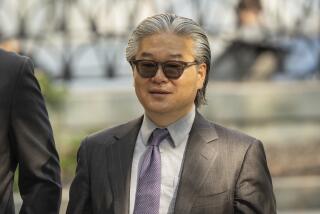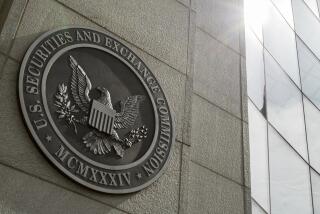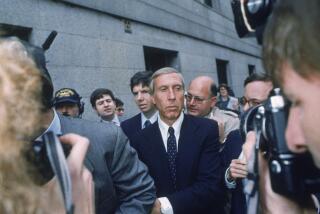Column: In legal settlement, Wells Fargo’s discredited ex-CEO gets a wet smooch from the SEC
In reporting the settlement the Securities and Exchange Commission announced Friday with former Wells Fargo Chairman and Chief Executive John G. Stumpf, at least one financial website described Stumpf as being “hit” with a $2.5-million penalty.
We don’t think “hit” is the right word. We’d suggest something more like “kissed.” Or “smooched.” Or “consoled.”
John Stumpf presided over a massive fraud at Wells Fargo, turning a blind eye even as many of his underlings sent up red flares. While the fraud was going on, he collected what can be estimated at about $300 million in cash, bonuses and stock options.
It’s not a hit, but a sweetheart deal that’s meaningless in terms of punishing and deterring a disgraceful series of violations.
— Stephen W. Hall, legal director at Better Markets
Of that largesse, the bank’s chastened board of directors clawed back about $69 million after Stumpf’s dereliction of duty was revealed. Earlier this year, Stumpf agreed to pay $17.5 million to other banking regulators.
That still leaves him with well more than $200 million, reckons Stephen W. Hall, legal director at the financial watchdog group Better Markets.
“It’s not a hit, but a sweetheart deal that’s meaningless in terms of punishing and deterring a disgraceful series of violations by Wells Fargo in which Stumpf was clearly involved and knew about,” Hall told me.
In February 2017, Wells Fargo put Stumpf’s stockholdings in the company at about 2.4 million shares, worth about $123 million at the time.
Wells Fargo agreed in February to a $3-billion settlement with the SEC and Department of Justice over the violations, which involved sales staff opening millions of bogus bank accounts for customers and others in order to meet punitive sales goals.
The company said Friday, “we have commented on these historical issues in the past and have nothing to add.”
Wells Fargo Chairman and CEO John G. Stumpf, who has been described as “the Mr.
Also Monday, the SEC filed a lawsuit against Carrie L. Tolstedt, Stumpf’s immediate underling who oversaw the sales campaign, charging her with civil fraud. Tolstedt is fighting the charges.
To add insult to injury, the SEC permitted Stumpf to settle its case without admitting or denying the commission’s findings. That makes a mockery of the assertion by the SEC’s enforcement director, Stephanie Avakian, that the settlement somehow demonstrates the SEC’s determination “to hold responsible ... senior executives who make false and misleading statements” in corporate disclosures.
Instead, the settlement demonstrates that “too-big-to-fail banks don’t face meaningful enforcement, punishment, deterrence,” Hall says. “You’ve got to go after the senior executives — and here they go after the senior executive but in a way that sends the wrong message, which is that you’re going to get off virtually scot-free.”
Why the SEC chose to finalize this settlement at this moment is a bit of a mystery. The wrongdoing at Wells Fargo, which was exposed in a series of articles in The Times in 2013, continued at least through 2015. Stumpf’s role was examined by regulators and congressional committees through 2016, when he was forced to resign.
Monday’s settlement has the flavor of a hasty wrap-up. Corporate accountability expert Nell Minow asked on Twitter whether it’s a “last-minute settlement before the new Biden sheriffs come to town.”
Wells Fargo Chairman and Chief Executive John Stumpf fulfilled the prediction of a growing volume of tea leaves Wednesday by announcing his immediate resignation from the bank company.
That’s an intriguing suggestion, given that some of the names being floated as SEC chairs in the new administration — among them Preet Bharara, the former U.S. attorney for the Southern District of New York and Gary Gensler, the former chair of the Commodity Futures Trading Commission — have a no-nonsense regulatory approach that probably leaves few dry seats in corporate suites on Wall Street.
To place the Stumpf settlement in context, it’s useful to recount what the SEC says he did (or didn’t do) as Wells Fargo’s boss.
Boiled down to its essentials, the SEC says it found that Stumpf lied to the public and to the commission by effectively concealing that the volume of new accounts — a metric the bank called a key factor in its business success — was significantly based on fraud. Among other practices, sales staff opened new accounts behind customers’ backs, leading to unexpected fees and in some cases overdrafts that exposed the customers to credit downgrades.
“Stumpf and Wells Fargo publicly stated ... that a core business strategy for the company ... was to ‘cross sell’ to customers accounts and products that they needed and used,” the SEC said Monday. In fact, by 2015, thousands of employees were busily opening accounts that “customers did not need, want or use.”
The independent investigation report into the Wells Fargo fraudulent account scandal, released early Monday, already is being described as “scathing,” and properly so.
Stumpf as CEO had information from Tolstedt and others “that put, or should have put, him on notice about material inaccuracies” in the financial statements he was signing. After The Times exposés, more than 1,000 employees were fired annually for these practices; Stumpf agreed that the number was not significant even though he had “reason to question” that conclusion, the SEC said.
The magnitude of Stumpf’s wrongdoing is shrouded in the SEC’s legal-speak — he “should have been put on notice,” he had “reason to question” what he was told, his “reliance on several senior officers ... was unreasonable,” and so on.
This is just weaseling. It’s fair to conclude that Stumpf knew what was going on. If the accountability mentioned by the SEC’s Avakian means anything, it’s that the man at the top shouldn’t be permitted to dodge responsibility by pointing the finger at the people he’s hired to work directly below him.
Indeed, in congressional testimony in 2016, Stumpf acknowledged that he was “fully accountable for all unethical sales practices in our retail banking business.” An investigation performed for the Wells Fargo board by the law firm Shearman & Sterling found that he “helped create the culture that resulted in sales practice abuses.”
Yet by failing to admit the SEC’s charges, Stumpf is still dodging responsibility.
“What you cannot do if you want accountability is let top executives get away with the defense, ‘I relied on others,’” Hall says. “He tried that, and the SEC let him off with that defense.”
More to Read
Inside the business of entertainment
The Wide Shot brings you news, analysis and insights on everything from streaming wars to production — and what it all means for the future.
You may occasionally receive promotional content from the Los Angeles Times.








